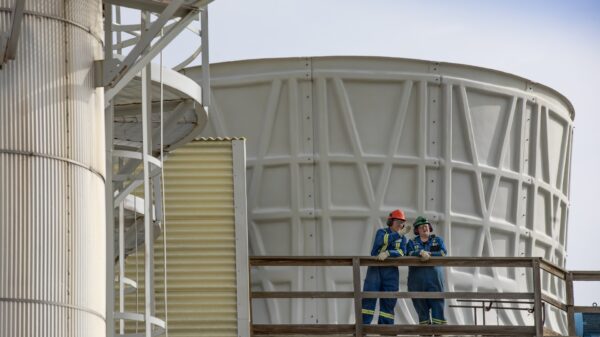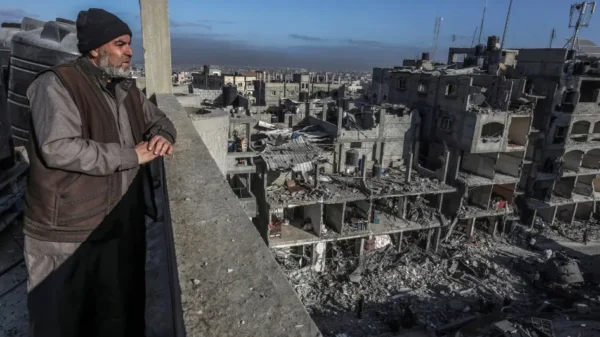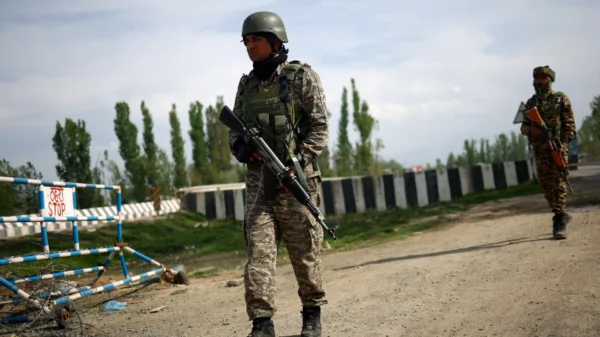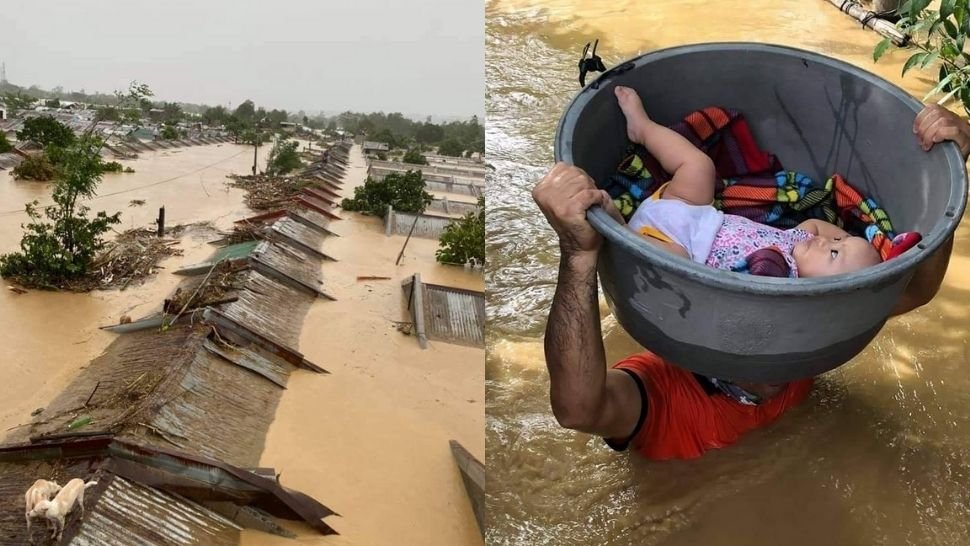Introduction
Typhoon Gaemi wreaked havoc as it made landfall in the Philippines, leaving a trail of destruction in its wake. The Philippine capital, Manila, faced severe flooding, submerging numerous neighborhoods and displacing thousands of residents. Alongside the widespread inundation, an oil tanker capsized off the coast, compounding the environmental catastrophe with a significant oil spill. These events have reignited urgent calls for robust climate action to mitigate such devastating impacts in the future.
The ferocity of Typhoon Gaemi underscores the increasing frequency and intensity of extreme weather events, often attributed to climate change. In Manila, the relentless rains overwhelmed drainage systems, turning streets into rivers and paralyzing daily life. Emergency services were stretched thin, striving to rescue those trapped by the rising waters and to provide essential aid to affected communities.
Meanwhile, the sinking of the oil tanker has raised severe environmental concerns. The spill threatens marine life and local fisheries, which are crucial sources of livelihood for many Filipinos. Efforts are underway to contain the spill, but the full extent of the ecological damage remains uncertain.
This catastrophic event has amplified the voices of climate activists and policymakers who emphasize the urgent need for comprehensive climate strategies. The Philippines, being highly susceptible to typhoons and other climate-related disasters, stands as a poignant reminder of the global climate crisis. The immediate aftermath of Typhoon Gaemi calls for not only immediate relief and recovery measures but also long-term plans to bolster resilience against future natural disasters.
As the nation grapples with the immediate effects of this disaster, the broader implications for climate policy and environmental stewardship are clear. It is crucial to address these challenges with a sense of urgency to protect vulnerable populations and to safeguard the environment against the escalating threats posed by climate change.
Typhoon Gaemi: A Deadly Force
Typhoon Gaemi emerged as one of the most powerful and destructive storms to strike Southeast Asia in recent years. Originating in the western Pacific Ocean, the typhoon rapidly intensified, reaching peak sustained wind speeds of 150 kilometers per hour (93 mph) and gusts up to 185 kilometers per hour (115 mph). Its path cut across the Philippine archipelago, exacerbating the already heavy monsoon rains, and resulting in widespread devastation.
The areas most affected by Typhoon Gaemi included the National Capital Region, Calabarzon, and Central Luzon. These regions experienced unprecedented rainfall, with some locations recording over 300 millimeters (11.8 inches) of rain in a single day. This deluge led to severe flooding, submerging homes, displacing thousands of residents, and causing considerable infrastructural damage. The typhoon’s impact was particularly harsh on the densely populated capital of Manila, where floodwaters inundated major roads, paralyzed transportation, and overwhelmed drainage systems.
The destructive force of Typhoon Gaemi was further amplified by its timing. The storm coincided with the peak of the monsoon season, leading to cumulative rainfall that far exceeded the region’s capacity to manage. This convergence of meteorological events highlighted the vulnerabilities of the existing infrastructure and the urgent need for improved disaster preparedness and climate resilience measures.
Comparatively, Typhoon Gaemi’s intensity and impact rivaled that of previous catastrophic typhoons such as Typhoon Haiyan in 2013 and Typhoon Bopha in 2012. However, Gaemi’s unique combination of high wind speeds and excessive rainfall presented a distinctive challenge, underscoring the growing unpredictability and severity of tropical storms in the context of climate change.
Impact on the Philippine Capital
The recent typhoon has wreaked havoc on the Philippine capital, causing unprecedented flooding that has left many areas submerged. The deluge has severely affected several districts, particularly the low-lying regions prone to water accumulation. Residential areas, commercial zones, and even critical infrastructure have not been spared from the floods, leading to widespread disruption and significant challenges for the inhabitants.
Among the hardest-hit areas are the districts of Manila, Quezon City, and Marikina. These regions have experienced extensive waterlogging, with some areas reporting water levels reaching up to several feet. The inundation has rendered roads impassable, hampering the movement of both people and essential goods. In many parts of the city, residents have been forced to evacuate their homes, seeking refuge in temporary shelters or with relatives in safer locations.
The flooding has also inflicted substantial damage on the city’s infrastructure. Power outages have become commonplace as electrical substations have been compromised by the rising waters. Public transportation services have been severely disrupted, with buses and trains either halted or rerouted due to submerged tracks and roads. Furthermore, healthcare facilities are struggling to cope with the influx of patients, as many hospitals and clinics have been partially flooded, complicating the delivery of medical services.
Local authorities have been working tirelessly to address the immediate needs of the residents. Emergency response teams have been deployed to rescue stranded individuals and provide essential supplies, such as food, water, and medical aid. Efforts are also underway to restore electricity and clear blocked roads to facilitate the movement of relief materials and personnel. However, the scale of the disaster has overwhelmed the capacity of the local government, prompting calls for additional support from national and international agencies.
Human Toll and Displacement
The recent typhoon that ravaged the Philippine capital has left a profound and indelible mark on countless lives. The human toll of this disaster is staggering, with reports indicating significant casualties and widespread displacement. According to recent data, over 600,000 people have been displaced from their homes, seeking refuge in temporary shelters and makeshift accommodations. The scale of this displacement has put immense pressure on local relief efforts, which are striving to provide essentials such as food, water, and medical care to those affected.
Personal stories from the displaced individuals underscore the severity of the situation. Maria Santos, a mother of three, recounted her harrowing experience: “The floodwaters rose so quickly. We barely had time to grab a few belongings before our house was submerged. Now, we are living in a crowded shelter, uncertain of what the future holds.” Her story is echoed by many others who have lost not only their homes but also their sense of security and normalcy.
Relief efforts have mobilized swiftly to address the needs of the displaced population. Non-governmental organizations (NGOs), local authorities, and international aid agencies have joined forces to provide immediate assistance and long-term support. The Philippine Red Cross has been at the forefront, distributing relief packs and setting up emergency medical stations to treat the injured and sick. The organization’s spokesperson, Roberto Cruz, emphasized the urgency of the situation: “Our priority is to ensure that everyone has access to basic necessities and medical care. The scale of this disaster is unprecedented, and we are doing everything we can to support the affected communities.”
Environmental Consequences
The aftermath of the typhoon that recently struck the Philippine capital has brought to light severe environmental consequences, particularly due to the capsizing of an oil tanker. The oil spill resulting from this maritime disaster poses an immediate and profound threat to marine life and ecosystems. The spread of oil can suffocate marine organisms, disrupt the food chain, and cause long-term damage to coral reefs and mangroves, which are crucial for coastal protection and biodiversity. The toxins present in the oil can have deleterious effects on fish populations, affecting both their health and reproductive capabilities.
Beyond the immediate impact on marine life, the oil spill introduces complex environmental challenges. The contamination of coastal areas can lead to the degradation of habitats crucial for various species of birds, fish, and other wildlife. Additionally, the cleaning and rehabilitation processes for such spills are resource-intensive and can take years, if not decades, to restore the affected areas fully. This not only impacts the environment but also the local communities that depend on these ecosystems for their livelihoods, particularly those involved in fishing and tourism.
Government and Emergency Response
The Philippine government’s response to the recent typhoon and subsequent flooding has involved a multi-faceted approach aimed at minimizing the disaster’s impact on its citizens. Emergency services were promptly mobilized, with evacuation procedures quickly put into action to safeguard residents in high-risk areas. The effectiveness of these evacuations has been largely praised, as many lives were saved due to timely warnings and organized transportation to safer locations.
Coordination of rescue operations was notably efficient, with various agencies working in tandem to ensure swift and comprehensive rescues. The National Disaster Risk Reduction and Management Council (NDRRMC) played a pivotal role, overseeing the deployment of rescue teams, including the military, local police, and community volunteers. Despite the challenging weather conditions, these teams managed to reach many of the affected regions, providing immediate relief and medical assistance.
In terms of aid distribution, the government’s efforts were focused on delivering essential supplies such as food, water, and medical kits to displaced families. Temporary shelters were established in schools and community centers, providing refuge to thousands. However, there have been criticisms regarding the speed and reach of aid delivery, especially in more remote areas where logistical challenges posed significant delays.
Critics have also pointed out the need for more robust infrastructure and better-preparedness plans to mitigate future disasters. While the immediate response was commendable, long-term strategies for climate resilience need to be prioritized. The government has acknowledged these concerns, indicating plans to invest in more sustainable infrastructure and enhance disaster response protocols.
Global Climate Context
The recent typhoon that has wreaked havoc in the Philippine capital is a stark reminder of the escalating impact of climate change on global weather patterns. As global temperatures continue to rise, the frequency and intensity of natural disasters, such as floods and typhoons, have seen a notable increase. The Intergovernmental Panel on Climate Change (IPCC) reports that the Earth’s average surface temperature has risen by approximately 1.2 degrees Celsius since pre-industrial times. This seemingly small increase has profound implications for weather systems worldwide.
Experts attribute the intensification of such extreme weather events to the warming of ocean waters, which fuels stronger storms. Dr. Michael Mann, a distinguished climate scientist, explains, “Warmer sea surface temperatures provide more energy for storms, leading to more intense and potentially more destructive typhoons and hurricanes.” The typhoon that recently hit the Philippines is a clear example of this phenomenon, demonstrating how climate change exacerbates the severity of natural disasters.
Moreover, changing weather patterns are not limited to tropical storms. The increased frequency of extreme rainfall events, which often lead to devastating floods, is another consequence of a warming planet. A study published in the journal Nature Communications highlights that for every degree Celsius increase in temperature, the atmosphere holds approximately 7% more moisture. This results in heavier and more sustained rainfall during storm events, overwhelming infrastructure and leading to catastrophic flooding.
The sinking of an oil tanker during the typhoon further underscores the cascading effects of climate change-induced disasters. The environmental and economic fallout from such incidents can be immense, highlighting the urgent need for robust climate action. Addressing the root causes of global warming and implementing adaptive measures is crucial to mitigating the impact of these increasingly frequent and severe weather events.
Calls for Climate Action
The recent typhoon that wreaked havoc in the Philippine capital, resulting in widespread floods and the sinking of an oil tanker, has reignited urgent calls for climate action. Local and international leaders have underscored the necessity of adopting comprehensive policies to mitigate the impacts of climate change. The devastation seen in Manila and surrounding areas serves as a stark reminder of the vulnerability of coastal and low-lying regions to extreme weather events.
Policy proposals focus on enhancing disaster preparedness, improving infrastructure resilience, and reducing greenhouse gas emissions. Local governments are pushing for stricter building codes, improved drainage systems, and the reinforcement of sea walls. Nationally, there is a strong push for renewable energy adoption and the implementation of sustainable agricultural practices to reduce the environmental footprint.
Internationally, cooperation is pivotal. Global leaders emphasize the importance of adhering to the Paris Agreement, with commitments to limit global warming to well below 2 degrees Celsius. Financial and technical support for developing countries, particularly those most affected by climate change, is deemed crucial. These nations often lack the resources to adequately prepare for and respond to natural disasters, making international aid and knowledge-sharing essential components of global climate strategy.
Environmental groups have been vocal in their advocacy, stressing that immediate and sustained action is imperative to prevent future crises. They call for greater investment in green technologies, reforestation projects, and sustainable urban planning. The voices of those directly impacted by the typhoon—families who lost homes, businesses that were destroyed, and communities grappling with the aftermath—are powerful testimonials to the human cost of climate inaction.




































